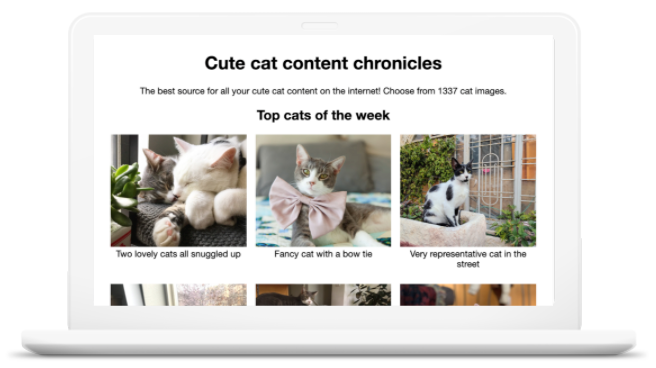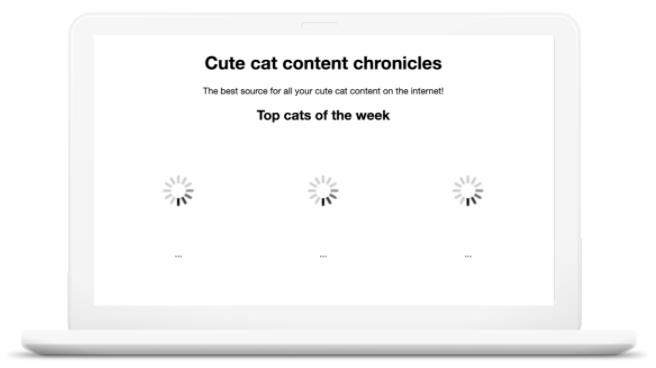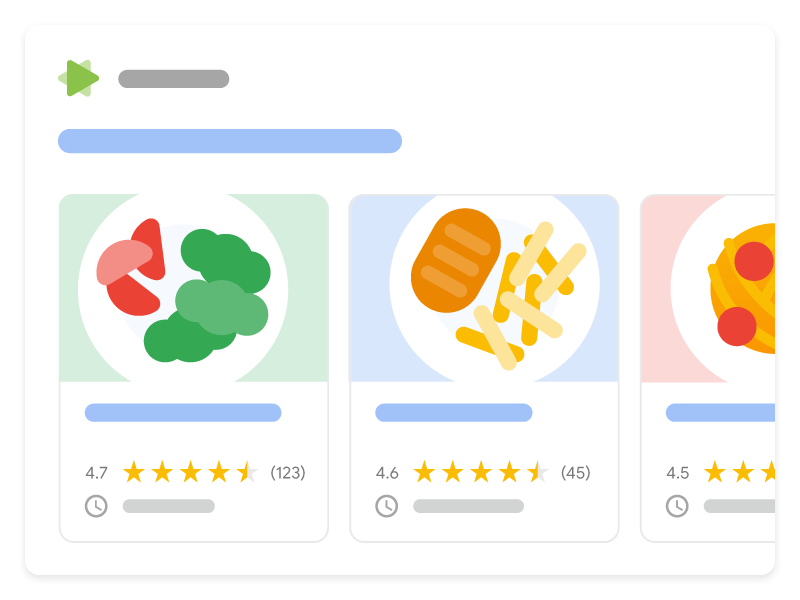بدء استخدام "بحث Google": دليل مطوّري البرامج
يجب أن يكون البحث عن المحتوى الخاص بك سهلاً حتى يتمكن المزيد من المستخدمين المهتمين من الاطّلاع عليه. يُطلَق على هذه العملية اسم "تحسين محرّكات البحث" وهي تساعد على جذب عدد أكبر من المستخدمين المهتمين بالمحتوى الخاص بك إلى موقعك الإلكتروني. وإذا واجه محرك بحث Google صعوبة في فهم صفحتك، قد يكون السبب أنك لم تُدرج أحد المصادر المهمة للزيارات.
يتناول هذا الدليل الإجراءات التي يمكن أن يتّخذها مطوّرو البرامج للتأكّد من أنّ مواقعهم الإلكترونية تتوافق مع "بحث Google". وبالإضافة إلى العناصر الواردة في هذا الدليل، احرص على أن يكون موقعك الإلكتروني آمنًا، وسريعًا، ومتاحًا للجميع، ومتوافقًا مع جميع الأجهزة.
التعرّف على كيفية ظهور موقعك الإلكتروني لمحرّك البحث Google
للبدء، يمكنك اختبار موقعك الإلكتروني باستخدام أداة فحص عنوان URL أو من خلال إجراء فحص النتائج الغنية بصريًا لمعرفة كيفية ظهور الموقع لمحرّك بحث Google. Googlebot هو برنامج تتبُّع من Google للزحف إلى المواقع الإلكترونية يعمل على اكتشاف الصفحات الجديدة والمعدّلة ويضيفها إلى "فهرس Google". لمزيد من المعلومات حول هذه العملية، يُرجى الاطّلاع على طريقة عمل "بحث Google".
يُرجى العِلم بأنّ محرّك بحث Google لا يرصد دائمًا كل ما يظهر لك على المتصفح. في المثال التالي، لا يرصد محرّك بحث Google أي صور تتضمنها هذه الصفحة لأنها تستخدم ميزة من JavaScript لا تتوافق مع Google.
إليك كيفية ظهور الصفحة للمستخدم. يستطيع المستخدم رؤية الصور والنصوص على المتصفح.

إليك كيفية ظهور الصفحة لمحرّك بحث Google. لا يرصد محرّك بحث Google أي صور تتضمنها هذه الصفحة لأنّها تستخدم ميزة من JavaScript لا تتوافق مع Google.

التحقق من الروابط
يتنقّل Googlebot من عنوان URL إلى آخر من خلال جلب الروابط وخرائط الموقع وعمليات إعادة التوجيه وتحليلها. ويتعامل Googlebot مع كل عنوان URL على أنّه العنوان الأول والوحيد على موقعك الإلكتروني. ولضمان إمكانية وصول Googlebot إلى جميع عناوين URL على موقعك الإلكتروني:
- استخدِم عناصر
<a>التي يمكن أن يزحف إليها Google. احرص على إتاحة إمكانية الوصول إلى كل الصفحات على الموقع الإلكتروني من خلال رابط مضمَّن في صفحة أخرى يسهُل العثور عليها. وتأكَّد من أنّ رابط الإحالة يتضمّن نصًا أو سمة النص البديل بالنسبة إلى الصور، ويجب أن يرتبط النص أو سمة النص البديل بالصفحة المستهدفة. - أنشِئ خريطة موقع وأرسِلها لمساعدة Googlebot على الزحف بفعالية أكبر إلى موقعك الإلكتروني. وخريطة الموقع هي ملف يمكنك استخدامه في تقديم معلومات عن الصفحات والفيديوهات والملفات الأخرى على موقعك وتوضيح العلاقات بينها.
- بالنسبة إلى تطبيقات JavaScript التي تتضمن صفحة HTML واحدة، تأكَّد من تضمين عنوان URL لكل شاشة أو جزء من المحتوى الفردي.
التحقّق من طريقة استخدام لغة JavaScript
يشغّل محرّك بحث Google لغة JavaScript، إلا أنّ هناك بعض الاختلافات والقيود التي تحتاج إلى أخذها في الاعتبار عند تصميم صفحاتك وتطبيقاتك من أجل تسهيل عملية وصول برامج الزحف إلى المحتوى وعرضه. اطّلِع على مزيد من المعلومات عن أساسيات تحسين محركات البحث المستندة إلى JavaScript أو طريقة إصلاح مشاكل JavaScript المتعلقة بخدمة "بحث Google".
يمكنك مشاهدة الفيديو التالي للاطّلاع على مزيد من المعلومات عن طريقة تعامل Google مع JavaScript عند الزحف والعرض والفهرسة.
إخبار Google بالتغييرات التي تطرأ على المحتوى
لضمان وصول محرّك البحث Google إلى صفحاتك الجديدة أو المُعدَّلة بسرعة، يمكنك:
إذا كنت لا تزال تواجه مشكلة في فهرسة صفحتك، تحقّق من سجلات خادمك بحثًا عن أي أخطاء.
أهمية النصوص في الصفحة
يستطيع Googlebot التعرّف على المحتوى النصي المرئي فقط. ولا يستطيع التعرّف على نصوص أخرى مثل النص الوارد في الفيديوهات. لتضمن أنّ محرّك بحث Google يفهم موضوع الصفحة، يمكنك اتّخاذ الخطوات التالية:
- كتابة وصف عن المحتوى المرئي: على سبيل المثال، إذا كانت صفحة فئة المنتج تتضمن قائمة صور لقمصان بدون وصف، تُعتَبر هذه الصفحة دون المستوى المطلوب. ومن المفترض أن تتضمن صفحة فئة المنتج نصًا يشرح كل صورة.
- التأكّد من أنّ جميع الصفحات تتضمن عنوانًا وصفيًا ووصفًا تعريفيًا: إنّ العناوين الفريدة والأوصاف التعريفية تساعد محرّك بحث Google في إظهار مدى صلة صفحاتك بطلبات البحث، ما يؤدي إلى ارتفاع عدد الزيارات إلى صفحاتك.
- استخدام ترميز HTML الدلالي: يستطيع محرّك بحث Google فهرسة ترميز HTML ومحتوى ملفات PDF والصور والفيديوهات، ولكن لا يستطيع فهرسة المحتوى الذي يتطلّب مكوّنات إضافية (مثل Java أو Silverlight) أو المحتوى الذي يُعرَض على لوحة رسم. وبالتالي، ننصحك باستخدام ترميز HTML الدلالي للمحتوى الخاص بك إن أمكن بدلاً من استخدام المكوّنات الإضافية.
-
تأكَّد من أنّه يمكنك الوصول إلى المحتوى النصي الخاص بك في
نموذج كائن المستند (DOM).
على سبيل المثال، لا يكون المحتوى الذي تتم إضافته عبر السمة
contentفي CSS جزءًا من DOM ويتجاهله محرّك بحث Google في الوقت الحالي. لا بأس في استخدام السمةcontentلإضافة المحتوى المستخدَم لغرض التصميم، لأنّ محرّك بحث Google قد لا يفهرس هذا النوع من المحتوى.
إخبار Google بالنسخ الأخرى من المحتوى
ليس بإمكان محرّك بحث Google أن يعرف تلقائيًا أنّ هناك عدّة إصدارات من موقعك الإلكتروني أو المحتوى الخاص بك. على سبيل المثال، لا يعرف محرك بحث Google تلقائيًا أنّ لديك إصدارًا مخصصًا لأجهزة الكمبيوتر وإصدارًا متوافقًا مع الأجهزة الجوّالة أو لديك إصدارات عالمية من موقعك الإلكتروني. ولضمان عرض Google للإصدار المناسب للمستخدمين، يمكنك:
التحكّم في المحتوى الذي يطّلع عليه Google
هناك عدّة طرق لحظر برنامج Googlebot:
- لمنع Google من العثور على صفحتك، يمكنك منح إمكانية الوصول إلى المحتوى الخاص بك للمستخدمين الذين سجّلوا الدخول حصرًا (من خلال مثلاً استخدام صفحة تسجيل دخول أو حماية صفحتك بكلمة مرور).
- لمنع Googlebot من الزحف إلى صفحتك، يمكنك إنشاء ملف robots.txt.
- لمنع محرّك بحث Google من فهرسة صفحتك مع السماح له بالزحف إليها،
يمكنك إضافة
علامة
noindex.
إذا كان محتواك لا يظهر في "بحث Google" وتريده أن يظهر، يُرجى اتّباع الخطوات التالية:
- تأكَّد من أنّ Googlebot يستطيع الوصول إلى الصفحة من خلال أداة فحص عنوان URL.
- اختبِر ملف robot.txt لمعرفة ما إذا كنت تمنع Googlebot بدون قصد من الزحف إلى موقعك الإلكتروني.
- تحقَّق من ملف HTML بحثًا عن قواعد
noindexفي علاماتmeta.
تفعيل النتائج الغنية بصريًا على موقعك الإلكتروني
قد تحتوي النتيجة الغنية بصريًا على أنماط أو صور أو ميزات تفاعلية أخرى تسمح بإبراز موقعك الإلكتروني على نحو أفضل ضمن نتائج البحث. يمكنك مساعدة Google في فهم صفحتك بشكل أفضل وإظهار نتائج غنية بصريًا منها على "بحث Google" من خلال تقديم مؤشرات صريحة عن مضمون الصفحة عن طريق إضافة بيانات منظَّمة إلى الصفحة. للاطّلاع على الميزات التي يمكنك إضافتها، يُرجى زيارة معرض الميزات المتوفّرة.

